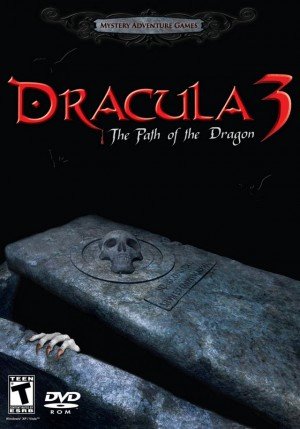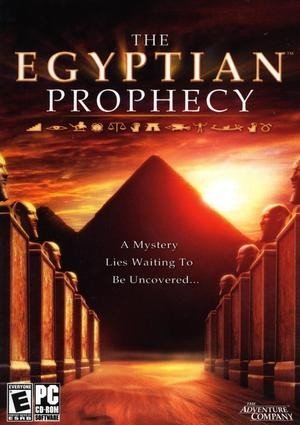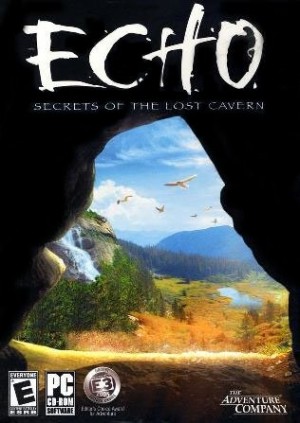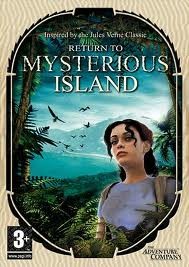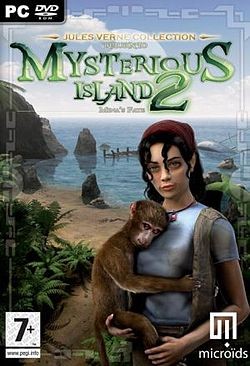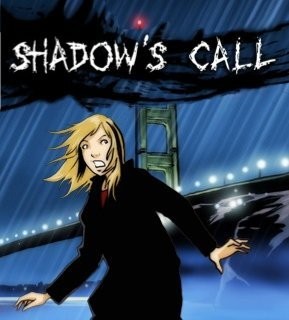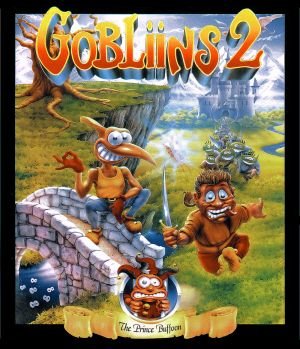Eye on iOS: Volume 3
Eye On iOS
Our regular round-up of iPhone, iPad and iPod Touch adventure games

It’s time again to cast another Eye on iOS, where we tip you off to the App Store’s hidden adventure gems so you can spend more time playing games, and less time trying to find them! This time I looked at a barrage of PC ports and Evan Dickens cozied up with two episodic iOS exclusives. Enjoy!
Kheops adventures
Several games from French developer Kheops Studio have found their way onto iOS platforms thanks to partnerships with publishers Chillingo and Coladia. These are a bit unusual among iPhone adventures in that they’re neither remastered oldies nor new games created specifically for the platform, but fairly recent PC adventures that have been ported and reworked. I checked out five Kheops games on my iPod Touch: Dracula: The Path of the Dragon, Egypt: The Prophecy, Secret of the Lost Cavern, Return to Mysterious Island and its sequel, Secrets of the Mysterious Island.
Though each game has a unique scenario, the look and feel of Kheops’ titles are fairly consistent across PC releases and this is true of the iOS ports as well. These games are all presented in first-person perspective. Node-based navigation allows you to pan 360 degrees around each environment by dragging your finger, and to move to the next area by tapping an exit. In general, the graphics and voice acting translate well to the small screen. The games balance stories inspired by history and literature with environmental and inventory-based puzzles; there’s some character interaction, but dialogue is secondary to puzzles.
If this sounds like your kind of adventure, Kheops’ App Store offerings are well worth a look. However, each of these has been changed to some degree from its PC counterpart, so be aware that the iOS versions may give you a scaled-down experience—and not just in the literal sense. Most of the Kheops games lack demos, but because they have a lot in common, playing one will give you a good idea of whether you’ll like the others. (Note: as these ports are Anuman Interactive/Tetraedge Games productions, Kheops is not listed as the games’ developer in the App Store. The easiest way to find these is to search for each by name.)
Dracula: The Path of the Dragon
Playing as Father Arno Moriani, you arrive in a small Transylvanian town to learn about the life and death of Martha Calugarul, a philanthropic doctor who is now a candidate for sainthood. As you might have guessed from the game’s title, there’s more to the doctor’s sudden death than meets the eye.
 Dracula is broken up into three $1.99 episodes in the App Store; my impressions are based on the first episode. Though it looks like the PC version and the general premise is the same, a glance at a PC walkthrough makes it clear that some gameplay in the iOS version has been streamlined or removed altogether. While this may not be glaring to players who haven’t experienced the original, I did feel like I’d been dropped into a large world where there wasn’t much to do. It doesn’t help that traveling from Point A to Point B requires moving through numerous dark, similar-looking and seemingly extraneous screens. In the first episode, at least, the puzzle-to-location ratio is pretty low.
Dracula is broken up into three $1.99 episodes in the App Store; my impressions are based on the first episode. Though it looks like the PC version and the general premise is the same, a glance at a PC walkthrough makes it clear that some gameplay in the iOS version has been streamlined or removed altogether. While this may not be glaring to players who haven’t experienced the original, I did feel like I’d been dropped into a large world where there wasn’t much to do. It doesn’t help that traveling from Point A to Point B requires moving through numerous dark, similar-looking and seemingly extraneous screens. In the first episode, at least, the puzzle-to-location ratio is pretty low.
In a new addition, a “permanent help” feature can be turned on or off from the game’s main menu. When this is on, arrows display at every exit, gear icons appear over characters or items you can interact with, and a hand icon appears on items you can pick up. When permanent help is turned off, you can still call up these icons by tapping a question mark on the screen. This sort of help is well suited to the handheld platform, since it can be hard to know what’s worth interacting with in detailed backgrounds on a small screen. The game saves automatically at certain checkpoints and also saves when you quit, giving you the ability to easily continue your game from the most recent point upon restarting.
Dracula has the production values you’d expect in a recent commercial release, with realistic background graphics and prerendered cutscenes. The cinematics appear a bit fuzzy, which surprised me since they’ve presumably been scaled down from the originals, but they’re still impressive by iOS standards. The game has both voice acting and subtitles, and you can easily skip dialogue lines by double tapping. But don’t get too tap-happy: when you engage in conversation, Father Moriani doesn’t speak his lines, so you need to read each option thoroughly before selecting it or you’ll lose the thread. In an odd quirk, characters’ lips don’t move when they talk.
With its plodding pace, I had a hard time getting into Dracula at the start, but I did start to see the story going in an interesting direction, and fans of gothic horror will probably get sucked in. For a better sense of the overall game, take a look at Adventure Gamers’ review of the PC version.
Egypt: The Prophecy
Despite the vastly different setting, Egypt: The Prophecy has a lot in common with Dracula. It, too, begins with the protagonist arriving in a new place to conduct an investigation. This time you play as Maya, a magician sent by the Pharaoh to investigate a series of accidents occurring at the site where an obelisk is being constructed as a gift to the gods.
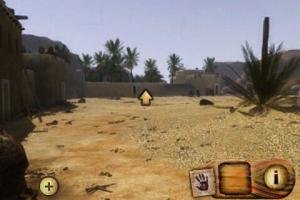 Also like Dracula, Egypt is broken up into three $1.99 episodes, the first of which I played. The interface, permanent help, and production values are very similar, but a few differences make Egypt the more refined of the two. Maya speaks her dialogue lines, for example, and supporting characters are lip-synched. There’s also a compass option in the menu, which I expected to display an actual compass to help with navigation, but turning it on or off didn’t have any noticeable effect in the episode I played.
Also like Dracula, Egypt is broken up into three $1.99 episodes, the first of which I played. The interface, permanent help, and production values are very similar, but a few differences make Egypt the more refined of the two. Maya speaks her dialogue lines, for example, and supporting characters are lip-synched. There’s also a compass option in the menu, which I expected to display an actual compass to help with navigation, but turning it on or off didn’t have any noticeable effect in the episode I played.
Unfortunately, Eygpt also shares some of the same pitfalls as Dracula, such as fuzzy cutscenes and a huge number of visually indistinct, seemingly unimportant screens with little payoff in the puzzle department. The save system is the same as well, with the game saving automatically at certain checkpoints and when you quit.
Given all the similarities between games, it’s not surprising that Egypt also gets off to a rather slow start, but once I started finding my way around it began to pick up. Read our PC review to get a better feel for the full version’s story and gameplay.
Secret of the Lost Cavern
Taking place in 15,000 BC, Secret of the Lost Cavern (also known as Echo on PC) is set in and around Lascaux, the site of famous prehistoric cave paintings. The protagonist, a young man named Arok, is on a quest to become a cave painter, and much of the gameplay involves creating paints and tools out of items such as branches, rocks, bones, and pigments. When this first launched for iOS it was divided into episodes, but it has since been re-released as one big game that currently sells for $2.99. I downloaded it before this transition, so my impressions are based on the first episode, which is the first of the full game’s four chapters.
 Secret of the Lost Cavern gets moving more quickly than Dracula and Egypt, with early scenes that take place in a self-contained environment, and more items to use and puzzles to solve from the get-go. The cutscenes seem crisper than in the other games and the outdoor environments look great, but the cave interiors are rather dark, which makes some of the fine details (such as a map etched into a rock) difficult to decipher.
Secret of the Lost Cavern gets moving more quickly than Dracula and Egypt, with early scenes that take place in a self-contained environment, and more items to use and puzzles to solve from the get-go. The cutscenes seem crisper than in the other games and the outdoor environments look great, but the cave interiors are rather dark, which makes some of the fine details (such as a map etched into a rock) difficult to decipher.
This game has a more robust help system than the others, with three levels that can be instantly adjusted by tapping a light bulb icon on-screen. When the light bulb is unlit, help icons are turned off but still display if you hover your finger over a hotspot, so you can easily sweep across the screen looking for interactive areas. Tap the light bulb once to turn on moderate help, which identifies hotspots but doesn’t indicate what you can do with them; tap it again to turn on full help that displays exactly where you can go and how you can interact. Other user-friendly features include an optional tutorial and an in-game journal that records Arok’s progress and offers hints for what else to try.
Voice acting is again present, although you can’t tap to skip through Arok’s lines. The portion I played didn’t include any interaction with other characters, so I’m not sure about lip sync or how the dialogue system works. The game auto-saves upon exit and you can also save manually.
I liked this game on PC (read the review to see why) and enjoyed what I played of the iOS version as well. If the premise intrigues you and you don’t mind squinting at a few of the darker screens, I recommend giving it a try.
Return to Mysterious Island and Secrets of the Mysterious Island
Inspired by the novels of Jules Verne, these games are set on the tropical island where Captain Nemo died, and his famed Nautilus ship plays a significant role in their stories. In Return to Mysterious Island, a lone shipwrecked sailor named Mina washes up on shore and must fight for survival while attempting to securing her rescue. In Secrets of the Mysterious Island (also known as Return to Mysterious Island 2: Mina’s Fate), when Mina’s rescue is botched, she and her simian companion, Jep, continue to unravel the island’s enigmas. Both the original game and its sequel sell for $2.99 and the first has a free demo. (When you go looking for these games in the App Store, you might also come across a free app named Return to Mysterious Island 2 iPhone Extension. This is a supplement to the PC game, not a demo for either of these ports.)
 I played the Return to Mysterious Island demo, which includes Mina’s first few tasks after arriving on the island, and an early portion of the sequel that included both Jep and Mina as playable characters. These games are the most complex of the Kheops bunch, thanks to their amazing amount of inventory item collection and combination. This makes the inventory itself an integral part of the game.
I played the Return to Mysterious Island demo, which includes Mina’s first few tasks after arriving on the island, and an early portion of the sequel that included both Jep and Mina as playable characters. These games are the most complex of the Kheops bunch, thanks to their amazing amount of inventory item collection and combination. This makes the inventory itself an integral part of the game.
Fortunately, Return to Mysterious Island has a helpful tutorial with step-by-step instructions on how to use each part of the inventory. Secrets of the Mysterious Island’s tutorial is much more abbreviated: one static screen that displays the first time you control Jep or Mina, with brief explanations of how each character can use the inventory’s functions. This single screen—presented before you’ve even picked up a single item—doesn’t provide quite enough context, and there’s no way to refer to it again later on. If you play the games in order you’ll already know the ropes, but if you choose to start with the sequel, figuring out the inventory will be part of the game’s challenge.
Each Mysterious Island game includes links to an online walkthrough, which is helpful but once again executed better in the first game. Return to Mysterious Island’s walkthrough can be pulled up at any time while playing, while in Secrets of the Mysterious Island the walkthrough can only be accessed from the main menu, and you need to be online to use it (it appears in a separate Safari window, automatically minimizing the game). Oddly, this walkthrough is also incomplete, only including the steps for solving the first few puzzles. In both games, the same permanent help options available in Dracula and Egypt are offered here, as is the compass option that has no obvious purpose (it’s actually grayed out in the menus, so I couldn’t even select it to give it a try).

Rather than prerendered cinematics, the Mysterious Island games have mostly comic-book style cutscenes made up of still graphics. These are a bit more stylized and visually appealing in the second game than the first. In both, the island’s scenery is bright and beautiful; in fact, of all the Kheops games I checked out for iOS, these were my favorites visually. Though the games again take place in a large world, the locations are more distinct, with landmarks that help with navigation. The Mysterious Island games are voice acted, and you can tap to skip Mina’s lines. I didn’t encounter other human characters in the segments I played, so I can’t comment on the dialogue system. The game saves automatically as Mina makes her way to different areas of the island and when you exit the game.
I enjoyed my time with these games and recommend them to adventure fans. Return to Mysterious Island seems more polished on iOS so I’d start there, then move on to Secrets of the Mysterious Island if you need another fix. For more details, take a look at Adventure Gamers’ reviews of Return to Mysterious Island and its sequel on PC.
Shadow’s Call
Evan Dickens
If you’re looking for a “dark urban fantasy” adventure with significant spiritual overtones for your iOS device, Imba Entertainment's Shadow’s Call may be just what the witch doctor ordered. The game puts you in the persona of Arielle Corvus, a young girl with the gift—or curse—of communicating with spirits, demons, and other other-worldly beings. She uses these abilities as a paranormal investigator, in between her day job of operating a rare bookstore. Unlike a certain other supernatural-focused book store-owning adventure hero, however, Arielle is a spunky little girl with the communication style of an addled teenager. When a fallen angel shows up needing a freeing spell in Arielle’s living room, the dark secrets of a college campus murder begin to come into focus—and I do mean “begin,” as this prologue chapter ends quickly with simply a teaser of the story that is to come.
 Shadow’s Call controls as a traditional point-and-tap adventure with a classic Full Throttle-style interface (except with a voodoo doll instead of a skull). This debut chapter has some introductory inventory puzzles, but contains really only one puzzle of substance that makes nifty use of the touch screen to complete an “unbinding” spell. There are only four locations offered here, but the art direction is bright and detailed and the animated sequences look outstanding.
Shadow’s Call controls as a traditional point-and-tap adventure with a classic Full Throttle-style interface (except with a voodoo doll instead of a skull). This debut chapter has some introductory inventory puzzles, but contains really only one puzzle of substance that makes nifty use of the touch screen to complete an “unbinding” spell. There are only four locations offered here, but the art direction is bright and detailed and the animated sequences look outstanding.
The music is suitably creepy and minimalist, and the game has full voice acting. This episode introduces a couple supporting characters through brief conversations that are clearly setting the stage for bigger things in the future. The dialogue has an uneven tone, and this game is not for the spiritually faint of heart, with its constant and heavy emphasis on supernatural beings. It’s a promising start, however, so it’s a shame there isn’t more substance to it, even at its affordable $1.99 price point. Currently only the prologue is available, and I’m inclined to recommend waiting until Chapter 2 shows proof of life... or afterlife.
Save Our Souls
Evan Dickens
French developer Medigames is a new studio focusing on games that integrate serious components of medicine and health with fictional stories. Save Our Souls, their first major project, is an episodic iOS adventure following the journey of a rookie paramedic who is still trying to recover from his dark past—a tragic accident that has left his girlfriend in a coma and turned his focus toward helping others.
 It’s an interesting framework, and the first episode is completely free, but unfortunately it indicates a lot of work left to do. For one thing, the broken translation to English is nearly incomprehensible (and not even always present, as some actions still prompt a French response), and even if the words make sense, the puzzle solutions still seem a bit confusing. Certain dialogue response options require unnatural events to cue them, and the game uses way too many keys as inventory items for its brief length.
It’s an interesting framework, and the first episode is completely free, but unfortunately it indicates a lot of work left to do. For one thing, the broken translation to English is nearly incomprehensible (and not even always present, as some actions still prompt a French response), and even if the words make sense, the puzzle solutions still seem a bit confusing. Certain dialogue response options require unnatural events to cue them, and the game uses way too many keys as inventory items for its brief length.
Save Our Souls makes use of a traditional point-and-tap interface, whereby tapping a selectable item brings up a list of actions you can perform. Even in the brief opening episode, which takes you on your first mission to save a man who has nearly drowned in a run-down hotel bathroom, there are quite a few inventory items to gather and use. The game looks decent, with some nifty in-game animations and an intriguing introduction, and seems competent at creating atmosphere—until the actual words start appearing.
A second episode is available now as a purchase only through the free first episode app, but until there’s some evidence that Medigames has enlisted the services of a good translator and puzzle designer, I’d have to recommend that we all save our money.
Gobliiins and Gobliins 2: The Prince Buffoon
Growing up as a Sierra fan whose game purchases were limited to what I could afford on my weekly allowance, I admired the Goblins series from a distance. These creative puzzle games were developed by French studio Coktel Vision, with Sierra as the publisher, so they’re totally different than the classic Quest series. Though I never got to play the originals, from what I can tell very little has changed in the recent iOS ports published by BulkyPix. The games have the same cartoon graphics, logic puzzles, and bizarre humor the series is known for—along with some unfortunate annoyances.
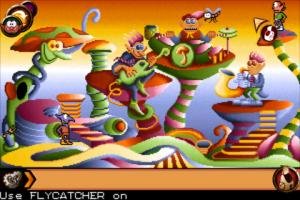 In these games, you control a team of goblins (three in Gobliiins and two in Gobliins 2, as represented by the number of is in the title). The goblins are on a quest, first to save the king from a voodoo doll-wielding adversary, then to rescue the king’s kidnapped son. The scenarios are less important than the puzzles, which mainly involve using each goblin’s special abilities to bypass obstacles and progress through the levels. For example, simply handing a diamond to a wizard who’s sitting at a high table involves a complex sequence of manipulating nearby items (such as carnivorous plants) to get a boost onto the table, and once you’re up there, getting the wizard to stop swatting you off again. Then, rather than launching into an interactive dialogue with the wizard whose attention you’ve worked so hard to gain, you’re whisked to the next scene where new obstacles awaits.
In these games, you control a team of goblins (three in Gobliiins and two in Gobliins 2, as represented by the number of is in the title). The goblins are on a quest, first to save the king from a voodoo doll-wielding adversary, then to rescue the king’s kidnapped son. The scenarios are less important than the puzzles, which mainly involve using each goblin’s special abilities to bypass obstacles and progress through the levels. For example, simply handing a diamond to a wizard who’s sitting at a high table involves a complex sequence of manipulating nearby items (such as carnivorous plants) to get a boost onto the table, and once you’re up there, getting the wizard to stop swatting you off again. Then, rather than launching into an interactive dialogue with the wizard whose attention you’ve worked so hard to gain, you’re whisked to the next scene where new obstacles awaits.
The games’ cartoon graphics have golden age nostalgia, with hand-drawn backgrounds that look great on the small screen. The sprites are a bit blocky by comparison, so it’s fairly obvious at a glance what’s part of the background versus what you’ll be able to pick up and move around. The goblins do have a number of amusing animations, with the characters jumping around, making faces, and doing funny things when something unexpected happens (or sometimes just because they’re bored). These are well done but the slapstick can quickly become tiresome, no thanks to the goblins’ babbling nonsense language and the oh-so-wacky soundtrack looping in the background. A few puzzles in, I was staving off a headache.
In Gobliiins, you can switch between touch control and cursor control; in Gobliins 2, only the cursor mode is available. This was an odd choice, since interaction is much more cumbersome when you have to drag the cursor across the screen to “point,” then tap to “click,” as opposed to the single tap provided by touch control. I had problems with my finger covering up hotspots, accidentally opening the inventory, or being physically incapable of positioning the cursor where it needed to be, especially with hotspots near the screen’s edge. In the first game, a goblin standing too close to a hotspot or his comrades would stand there doing nothing as I tried in vain to make him go, while in the sequel, text displays stating that the goblin is too close and to move him and try again. (When the goblins need to be near each other to solve a puzzle, that’s easier said than done!) I suppose the error message is better than nothing, but it would have been better still for the developers to resolve the problem. Such glitches serve as constant reminders that these are computer games that were simply shrunk down to the small screen.
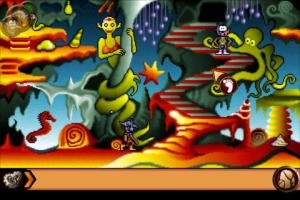
To make matters worse, the controls are frequently unresponsive. The goblins don’t always go where you tell them to or engage with the hotspots you select. Puzzles in both games require teamwork among the playable goblins, but it can be very hard to get the timing right for activities that require synchronized actions. An icon can be tapped to easily switch between the playable goblins, but this is buggy; sometimes the goblin responding to your input is not the one displayed.
In Gobliiins, your team includes a magician who can cast spells, a warrior who can punch things, and a technician who can pick up and use items, while in Gobliins 2 you have one goblin who’s more mischievous and daring, and another who’s more practical and careful. Since the world has its own unique logic, it’s impossible to anticipate how the situation will play out differently using different goblins. This is part of the game’s challenge, but since the finicky iOS controls aren’t well suited to trial and error, I wanted to have an idea of what my efforts would yield before going to the trouble. Compounding this, in Gobliiins the trio has a health meter that depletes as you try certain incorrect solutions, punishing the very trial and error the gameplay requires. After a few wrong moves, you die and the level restarts. Thankfully this “feature” is absent in Gobliins 2.
The first game’s puzzles are contained in a series of single locations, essentially making them “escape the room” scenarios. Once you solve a puzzle you progress to the next screen, with no opportunity to wander and explore at your leisure (and no real reason to, since all interactions are directly tied into the puzzles you’re trying to solve). In the sequel, puzzles sometimes span a few locations and you can travel between these at will, either by exiting at the side of the screen or selecting the location you want to visit from a “Move To” menu. But moving around is still pretty limited, and once you’ve completed a level, you progress directly to the next.
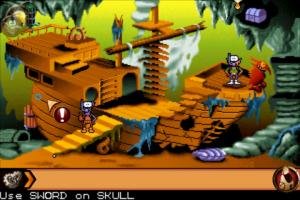 The games have built-in help systems that provide three levels of tiered “hints” serving more as blow-by-blow instructions. Some in Gobliins 2 assume you’ve already completed a sequence in another location, thus inadvertently spoiling puzzles you didn’t ask for help with. Even so, it’s a nice addition that makes the game somewhat more palatable for a modern audience. Without the hints, I would have quit out of frustration in the first few minutes. Gobliiins has an auto-save that allows you to continue from the screen you were on when you quit (but not the state you left it in) as well as traditional save slots. Gobliins 2 lacks the auto-save, but it does prompt you to save your game before quitting.
The games have built-in help systems that provide three levels of tiered “hints” serving more as blow-by-blow instructions. Some in Gobliins 2 assume you’ve already completed a sequence in another location, thus inadvertently spoiling puzzles you didn’t ask for help with. Even so, it’s a nice addition that makes the game somewhat more palatable for a modern audience. Without the hints, I would have quit out of frustration in the first few minutes. Gobliiins has an auto-save that allows you to continue from the screen you were on when you quit (but not the state you left it in) as well as traditional save slots. Gobliins 2 lacks the auto-save, but it does prompt you to save your game before quitting.
You can find Gobliiins and Gobliins 2 in the App Store for $2.99 each. At that price, it’s hard to go too far wrong, but since I’d always been curious about them, I was disappointed by the iOS execution. Those who played and enjoyed the Goblins series in the early 1990s might fare better than I did, but for a first-timer playing the originals on PC is probably a better way to go, since GOG.com has them bundled, along with the third Goblins game, for $5.99.



